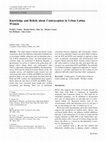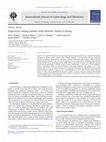Papers by pavithra pavithra venkat

Journal of Community Health, 2008
Our study aimed to identify perceptions Latina women have about four different contraceptive meth... more Our study aimed to identify perceptions Latina women have about four different contraceptive methods and to investigate whether religiosity and acculturation play a role in their contraceptive choice. An observational cross-sectional study was performed at Bellevue Hospital. A questionnaire was given to women in the gynecology outpatient clinics asking about: oral contraceptive pills (OCP’s), injectable contraception (DMPA), the Intrauterine device (IUD) and the Ortho-Evra Patch (Patch). In the 102 complete surveys, self identified Latina women were not convinced of the safety of OCPs and DMPA (less than 50% perceived them to be safe) and largely uncertain about the Patch and IUD. Latinas also demonstrated more negative beliefs about the side effects of OCPs and DMPA. In particular, they were concerned about weight gain, method reversibility, and bleeding. There was no substantial correlation between religiosity and contraceptive beliefs. Low level acculturated women were more likely to believe that the IUD and OCPs were harmful, as opposed to their more acculturated counterparts who demonstrated more negative beliefs about the Patch. Overall, Latina women in this study tended to overrate the risks associated with contraceptive use, particularly OCPs and DMPA. The markedly low method confidence suggested by high rates of “unsure” answers is a possible explanation for why Latinas are less adherent with birth control than their white counterparts.

Gynecologic Oncology, 2010
To determine, through a pilot study, whether use of a video-based educational tool can influence ... more To determine, through a pilot study, whether use of a video-based educational tool can influence overall human papillomavirus (HPV) vaccine acceptability, views on vaccine mandates, school vaccination, and acceptable age for vaccination. Written surveys addressing HPV knowledge and vaccine acceptability were administered to study participants from January to March 2007. An initial 32-question survey was completed, followed by an 8-minute educational video, and a post-video assessment. Out of 256 subjects, 73.0% watched the video and completed all surveys. Eighty percent of the subjects had heard of HPV, while 65.0% knew, prior to viewing the video, that the vaccine was available. Individual vaccine acceptability increased from 66.7% to 78.0% after the video (p=.0014). Prior to the video, 54.8% of subjects supported mandatory HPV vaccination, with 51.1% supporting school vaccination, and 66.7% accepting vaccination if it were free. After the video, these percentages increased to 72.6% (p<.0001), 65.1% (p<.0001) and 86.6% (p<.0001) respectively. Initially, 56.5% of subjects would vaccinate their child at 15 years of age or younger. After the video, 94.1% approved of vaccination from age 9 (p<.0001). Secondary analysis revealed Hispanics, African Americans, and lower income families were more likely to accept HPV vaccination after the video. A perception that vaccination promotes sex, and whether or not participants talk to their children about sex, did not affect acceptability. Using an educational video significantly increased overall HPV vaccine acceptability and acceptance in younger age groups. This may be an effective means of increasing awareness and acceptability of HPV vaccination.

Journal of Lower Genital Tract Disease, 2010
The Hybrid Capture II assay (hc2; QIAGEN, Inc) for high-risk human papillomavirus (hrHPV) is an i... more The Hybrid Capture II assay (hc2; QIAGEN, Inc) for high-risk human papillomavirus (hrHPV) is an in vitro nucleic acid hybridization assay using chemiluminescence for the qualitative detection of hrHPV DNA in cervical samples. Results are reported as a ratio of relative light units (RLUs) to a cutoff value based on a positive control. Specimens with RLU ratios of 1.0 or higher are scored positive for hrHPV. We tested the hypothesis that hrHPV positives with low-positive RLU ratios (1-10) had a lower prevalence of cervical intraepithelial neoplasia 2,3 (CIN 2,3) on histologic follow-up. Relative light unit ratios for 388 consecutive hrHPV-positive cervical cytologic specimens interpreted as atypical squamous cells of undetermined significance (ASCUS) were reviewed. Individual RLU ratios were compared with outcome histologic diagnosis in cases with colposcopic follow-up and tissue sampling (biopsy and/or endocervical curettage; n = 236). Of 236 cases with histologic follow-up, 63 had RLU ratios in the range of 1 to 10; of these, 53 (84.1%) were negative for CIN, 7 (11.1%) had CIN 1, 1 (1.6%) had CIN of uncertain grade, and 2 (3.2%) had CIN 2,3. The difference in CIN 2,3 outcome between RLU ratios of 1 to 10 (3.2%) versus over 10 (17.3%) was significant (p =.0047). The difference in prevalence of CIN 1 was not significant (p =.67). An RLU ratio of 10 or less was associated with a significantly lower prevalence of CIN 2,3 on biopsy outcome after a Pap test result of ASCUS. The much lower prevalence of underlying CIN 2,3 in patients who are weakly HPV-positive may justify modification of the management algorithm for this subset of women with ASCUS.

International Journal of Gynecology & Obstetrics, 2011
Objective: To establish the prevalence of depression and describe associated factors among fistul... more Objective: To establish the prevalence of depression and describe associated factors among fistula patients attending an obstetric fistula surgical camp in Kenya. Methods: A cross-sectional study was conducted focusing on obstetric fistula patients attending a national fistula camp held in August 2008 at Kenyatta National Hospital, Nairobi, Kenya. A structured questionnaire was used to obtain sociodemographic data and medical histories for all consenting patients before surgery. Depression measures were obtained using the Patient Health Questionnaire-9. Results: Of the 70 women interviewed, 2 (2.9%) and 12 (17.1%) reported a history of psychiatric illness and suicidal ideations, respectively. Depression was present in 51 (72.9%) patients, with 18 (25.7%) meeting criteria for severe depression. Depression was significantly associated with women older than 20 years of age (P = 0.01), unemployment (P = 0.03), lack of social support following fistula (P = 0.04), and living with fistula for over 3 months (P = 0.01). Conclusion: Women with obstetric fistula are predisposed to high levels of depression. A holistic management approach, including mental health care and family support, is recommended.
Uploads
Papers by pavithra pavithra venkat